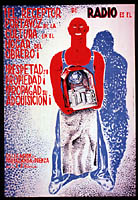 |
!El receptor de radio es el portavoz de la cultura en el hogar del obrero¡ !Respetad su propiedad¡ !Propagad su adquisición¡
[The radio receiver is the mouthpiece of culture in the home of the worker! Respect its property! Propagate its acquisition!]. . Delegación de Propaganda y Prensa del C.E.P., Valencia. Lit. V. Mirabet. Intervenido U.G.T. C.N.T. Lithograph, 3 colors; 70 x 48 cm.
|
|
Here, the viewer is counseled
not to steal radios, while radio sales are also promoted. The figure
in the poster, a worker with a devilish grin and beady eyes, seems
to be in the act of absconding with a radio. Propaganda encouraging
workers to respect private property was not rare during the war
era. After all, it was a revolutionary setting in which the threat
to individual possessions was very real, ranging from more legitimate
claims on property by workers who aimed to collectivize, to outright
theft by those using the war as an excuse to plunder. The reason
to single out the radio as the object to be protected may lie in
the tremendous importance that the radio had during the war: its
powerful presence drew people together, animated them for battle,
or soothed their worries about casualties. A contemporary observer
describes how Spaniards sat breathlessly around their radios, waiting
to hear the latest news about the Rebel approach on the capital
city of Madrid: "Thousands upon thousands of bodies sat tensely
[by the radio] in eager anticipation. In the sky and on earth there
was a cosmic silence."
The radio not only provided
a way to rally one's own forces, it also afforded the ability to
shake the other side. For the first time, the radio supplied a way
to communicate with those on the opposite side of the front. For
example, to scare the citizens of Madrid in the days before their
invasion of the capital, the Rebels broadcast radio programs describing
the mythical entry of Franco into Madrid on a white horse and the
places in the city where they would punish Republican supporters.
In addition to being a powerful propaganda tool, the radio also
played a key role in the war effort itself. Both sides used the
radio to transmit secret orders and to listen in on enemy reports.
Occasionally, military leaders even broadcast false information
in order to trick their opponents, who were most likely listening
in.
The author of this anonymous
poster may be an anarchist artist from Valencia by the name of Juan
Borrás Casanova (1909-1987). This is suggested by the striking
similarity of both the design and type of figure in this poster
and others signed by Casanova. Besides contributing to the design
of posters during the war, Casanova participated in the Spanish
Pavilion in the International Exhibition in Paris in 1937.
|




